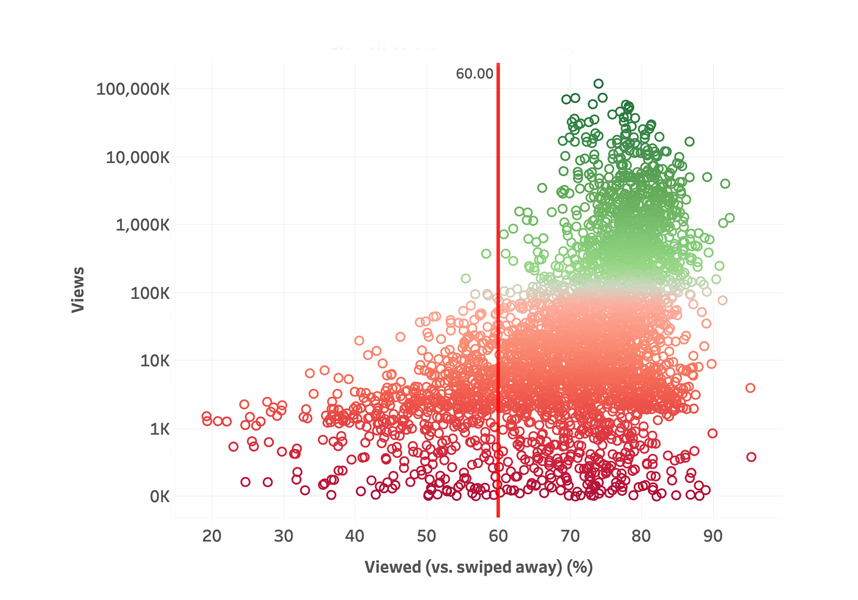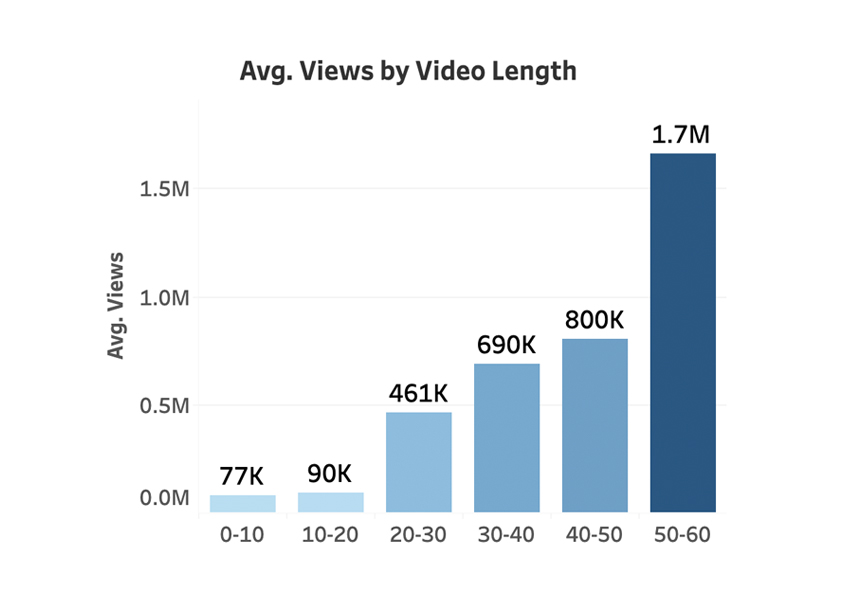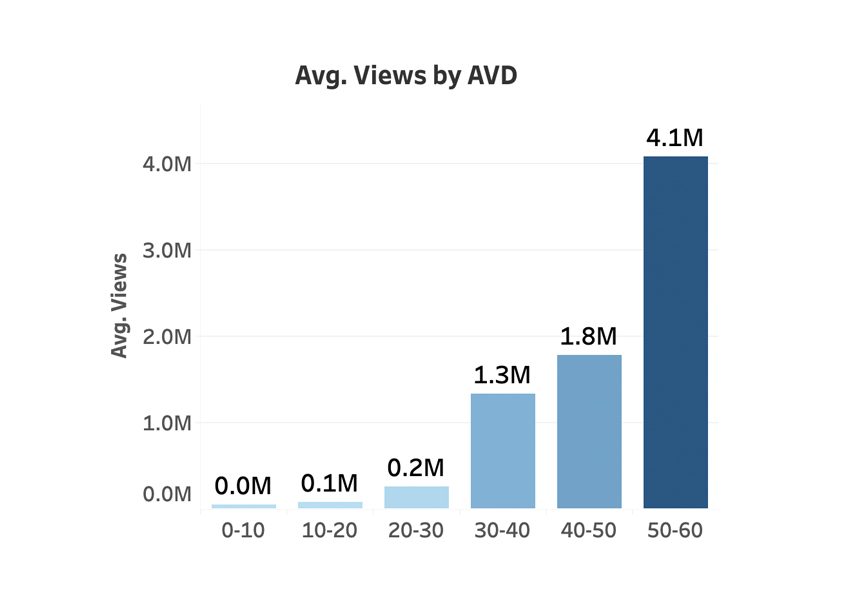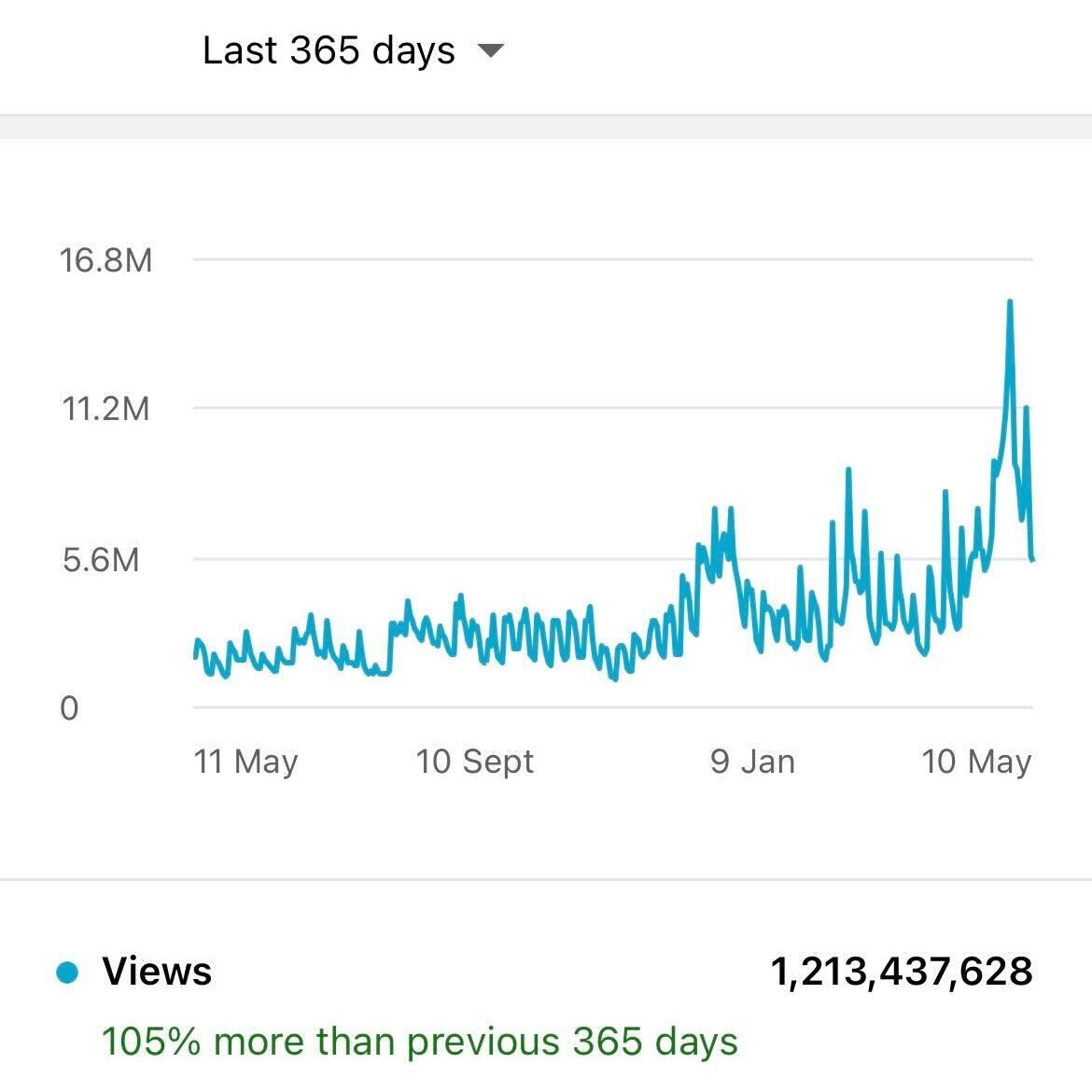We studied 3.3 Billion views to decode the YouTube Shorts algorithm.
What makes a short viral?
How much money can they make?
Are they actually good for growth?
Here are our findings:
What makes a short viral?
How much money can they make?
Are they actually good for growth?
Here are our findings:

This study was conducted across 33 YouTube channels in different niches with 5,400 shorts included.
Myself and my lead analyst Chris Gileta put a ton of work into this, and the results are interesting.
Let's start with a question: ''What length should my shorts be?''
Myself and my lead analyst Chris Gileta put a ton of work into this, and the results are interesting.
Let's start with a question: ''What length should my shorts be?''
So looking at the shorts included in our study, this graph shows the distribution by video length.
Pretty nice spread, but most people appear to be making shorts between 20 and 40 seconds.
Really short shorts (lol) were pretty rare.
Pretty nice spread, but most people appear to be making shorts between 20 and 40 seconds.
Really short shorts (lol) were pretty rare.

But what is the best length to make for performance?
The initial findings here show a clear relationship between length and views. Longer shorts in the study performed much better on average.
There will be other forces at play here, but this is pretty staggering.
The initial findings here show a clear relationship between length and views. Longer shorts in the study performed much better on average.
There will be other forces at play here, but this is pretty staggering.

Looking at average view duration and views, the gap becomes even bigger.
Shorts where the AVD was higher than 50 seconds averaged 4.1 million views.
Just making a long short isn't the goal, making a short that holds people for as long as possible is.
Shorts where the AVD was higher than 50 seconds averaged 4.1 million views.
Just making a long short isn't the goal, making a short that holds people for as long as possible is.

Takeaway #1
The shorts algorithm does (unsurprisingly) appear to favour longer videos that hold viewer duration well.
However, there were outliers at all lengths. So don't feel you have to make your video a certain length.
The shorts algorithm does (unsurprisingly) appear to favour longer videos that hold viewer duration well.
However, there were outliers at all lengths. So don't feel you have to make your video a certain length.
What else does the shorts algorithm look at?
YouTube recently added this metric, is it useful? Or is it like CTR for long form videos, an important performance metric for Youtube's recommendation system, but rarely that helpful to creators.
YouTube recently added this metric, is it useful? Or is it like CTR for long form videos, an important performance metric for Youtube's recommendation system, but rarely that helpful to creators.

So here's our initial results (subject to more testing). This graph shows the % of viewed vs swiped away (VVSA) along the bottom.
As you can see by the line, shorts with under 60% VVSA rarely performed well (red).
The best performing shorts were typically between 70 and 90%.
As you can see by the line, shorts with under 60% VVSA rarely performed well (red).
The best performing shorts were typically between 70 and 90%.

However, it's pretty clear that having a high % here doesn't guarantee success (much like CTR for long form videos).
So pay attention to this metric, but don't obsess over it. If you get under 60% here though, you're probably in trouble!
So pay attention to this metric, but don't obsess over it. If you get under 60% here though, you're probably in trouble!
What about engagement metrics? Likes, shares, comments etc?
We didn't observe any strong relationships with performance here. That's not to say they don't matter. Like with the long-form algorithm, Youtube may consider them for satisfaction scoring.
More testing needed.
We didn't observe any strong relationships with performance here. That's not to say they don't matter. Like with the long-form algorithm, Youtube may consider them for satisfaction scoring.
More testing needed.
Takeaway #2
Viewed vs swiped away is worth paying attention to, it's important to make your first second really punchy and engaging to hook viewers early into the video. Treat your intro like a thumbnail.
Engagement metrics don't seem massively important, but will test more.
Viewed vs swiped away is worth paying attention to, it's important to make your first second really punchy and engaging to hook viewers early into the video. Treat your intro like a thumbnail.
Engagement metrics don't seem massively important, but will test more.
Ok, so for people trying to understand the shorts algorithm. This is all you really need to know:
Youtube will personalise recommendations of shorts (i.e look at watch history to see what someone likes) and show enjoyable shorts that hold attention well to them.
Simple.
Youtube will personalise recommendations of shorts (i.e look at watch history to see what someone likes) and show enjoyable shorts that hold attention well to them.
Simple.
But, are shorts even worth doing? Let's first look at sub conversion.
A lot of people have claimed shorts are ''cheat codes'' for subscriber growth (myself included) but does this hold up?
A lot of people have claimed shorts are ''cheat codes'' for subscriber growth (myself included) but does this hold up?
Well actually, our initial findings here show that on average long-form videos still convert subscribers better (per 10,000 views) than shorts.
I was a little surprised by this.
I was a little surprised by this.

However, this completely changes when filtering to channels with over 1m subs. Shorts outperform in terms of sub conversion.
Why? My theory is these channels are making better shorts on average that reach more viewers, and are using better call-to-actions inside those shorts.
Why? My theory is these channels are making better shorts on average that reach more viewers, and are using better call-to-actions inside those shorts.

Takeaway #3
Shorts are definitely a good way to grow your subscribers, especially considering how much lower effort is involved vs a long form video.
Important to note: Sub counts are not overly important in 2023, but everyone wants more!
Shorts are definitely a good way to grow your subscribers, especially considering how much lower effort is involved vs a long form video.
Important to note: Sub counts are not overly important in 2023, but everyone wants more!
So shorts can bring in a lot of subscribers, but can they make meaningful money?
What sort of RPMs ($ per 1000 views) are people seeing with shorts?
I've heard a lot of people say that the new shorts split (Feb first) is the same or worse than the shorts fund, is that true?
What sort of RPMs ($ per 1000 views) are people seeing with shorts?
I've heard a lot of people say that the new shorts split (Feb first) is the same or worse than the shorts fund, is that true?
Well the RPMs are nothing to get too excited about, but the new partner split is more than double the shorts fund on average. Myth busted!
I see this as promising, with time YouTube will likely improve this, but for now 6 cents seems to be the average.
I see this as promising, with time YouTube will likely improve this, but for now 6 cents seems to be the average.

Unlike long form videos, the length of the short doesn't seem to lead to a meaningful difference in RPMs. 

Takeaway #4
Shorts definitely aren't money makers (yet). However, let's give it time, I expect this RPM to rise over the next 12 months.
Shorts definitely aren't money makers (yet). However, let's give it time, I expect this RPM to rise over the next 12 months.
So are shorts worth it? I think so. If you can do them without taking away focus from your long form videos, go for it!.
If you found this helpful, all I ask for is a like and retweet on the first tweet ♥️ I'll send one person who does so $200!
If you found this helpful, all I ask for is a like and retweet on the first tweet ♥️ I'll send one person who does so $200!
Shoutout to Chris on my team (@Biasedobsrvr) for working on this research. We've planned this for a while!
This is just the start of the research we are doing. We will be releasing a full white-paper report on shorts soon, with bigger sample size and more takeaways!
This is just the start of the research we are doing. We will be releasing a full white-paper report on shorts soon, with bigger sample size and more takeaways!
This analysis is time intensive, it's the sort of thing we usually keep to clients, but we wanted to share these initial findings with the public.
The sample size on this study was large enough to get a good picture, but this is still early research. We're building out a bigger sample size for our white-paper, we made over 50+ graphs!
Averages can lie sometimes, so we double checked against medians throughout. 🙂
Averages can lie sometimes, so we double checked against medians throughout. 🙂
Well this went viral
Chris and I will be sharing more analysis in a newsletter dropping Monday!
Sign up here: paddygalloway.com/join
Chris and I will be sharing more analysis in a newsletter dropping Monday!
Sign up here: paddygalloway.com/join

• • •
Missing some Tweet in this thread? You can try to
force a refresh

 Read on Twitter
Read on Twitter








